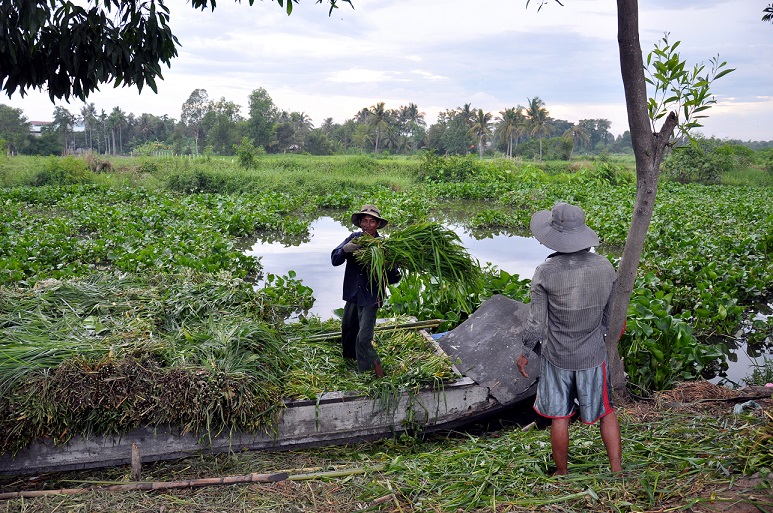The rapid urbanization of Ho Chi Minh City’s suburban areas has lead to construction taking over the metropolitan area’s vast fields, leaving grass for cattle in high demand and creating job opportunities for poor citizens.
Grass markets have become a common sight in Ho Chi Minh City’s outlying districts, supplying farmers with grass for cattle feed in response to the urbanization that is laying claim to the area’s grazing fields.
Entrepreneurial suburban residents seeking a silver lining in the dwindling of the area’s grasslands are turning to “grass collecting” as a means to make a living while supplying the city’s farmers with cattle feed.
Thach Be Cuong, is just one of the suburban locals who has adopted the new profession. Joined by his five-man crew, Cuong begins his work day at 1:00 am and finishes up around 4:00 pm by a canal in Hoc Mon District in the southern hub.
“Our job depends heavily on tidal water along rivers in the city. We travel on our raft to the harvest field when water levels rise and begin collecting grass when it falls,” Cuong elaborated.
The grass farmer then showed his ‘catch’ of the day - 1,500 whisks, each weighing between four and five kilograms. Cuong says each member of his team can earn VND250,000 (US$11.21) with such a harvest.
Hoang Em, another local grass harvester, said an average worker can earn VND180,000 ($8) by collecting about 200 whisks of turf on a daily basis.
‘Veteran’ harvesters can collect up to 300 whisks a day, Em continued, adding that the physical cost of collecting such a harvest includes being partially underwater for three to five hours.
“Grass is most abundant along the river bank in District 2, Thu Duc District, and Binh Thanh District. While working in those environments we are constantly exposed to mosquitoes and other insects,” the man said.
“Female workers also risk infection from gynaecological diseases due to long hours in the water,” he added, “but they take the risk to earn a living.”
According to Huynh Van Dat, an owner 20 milk cows in Hoc Mon, the number of dairy farmers in the district has rocketed in recent years.
As grassy areas disappear, cattle operators of cattle farm are forced to buy grass from harvesters.
Facing myriad risks
“Thanks to the new profession, our lives are improving. My three children are back in my hometown in the countryside and are able to receive a proper education,” Thach Ut, a grass harvester said.
Though the job is physically demanding, workers can only afford to sleep for a few hours each day, Ut added.
Traveling along the canals also poses several risks from Mother Nature, Tu Lam, Ut’s colleague continued, stating that extreme heat in the dry season and lightning in rainy season are a serious threat.
According to Thach Ba La, Cuong’s wife, the grass collectors can be recognized by their skinny physique and dark-toned skin.
Showing her hands wrinkled and damaged by water, La expressed her hope for a stable job and steady income.
At sunset each day, harvesters with soaked outfits clinging to their bodies walked back to their tenanted houses, hurrying to grab a bite to eat and get in a few hours of sleep before preparing for their next busy day.
Like us on Facebook or follow us on Twitter to get the latest news about Vietnam!





















































